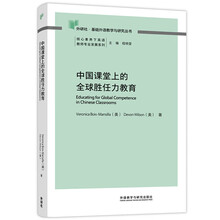CHAPTER ONE INTRODUCTION
1.1 Motivation for the Current Study
1.2 ELT in China
1.2.1 Policy of ELT: An Overview
1.2.2 Development of the English Language Teaching Syllabi for Secondary Schools
1.2.3 Reform of the Curriculum
1.2.4 Changes and Challenges Encountered in ELT
1.2.5 The First English Immersion Program in China -- the CCUEI
1.3 Aim of the Study and Research Questions
1.4 Significance of the Study
1.5 Outline of the Thesis
CHAPTER TWO IMMERSION EDUCATION
2.1 Immersion Education in Canada
2.1.1 Definition of Immersion
2.1.2 Features of Immersion
2.1.3 Varieties of Immersion Programs
2.2 Immersion Education in Other Western Countries
2.3 English Immersion Program in China-- the CCUEI
2.3.1 Characteristics of the CCUEI
2.3.2 Research on the CCUEI Program
2.4 Challenges to Immersion Education Worldwide
2.5 Research Gap
2.6 Summary
CHAPTER THREE INTERACTION, ACTIVITY AND PEER TALK
3.1 Cognitive and Sociocultural Paradigms in Interaction
3.1.1 Interaction within the Cognitive Paradigm
3.1.2 Interaction within the Sociocultmal Theoretical Paradigm
3.2 The Role of Tasks and Activities in Interaction
3.2.1 Tasks and Activities from a Psycholinguistic Perspective
3.2.2 Tasks and Activities from a Sociocultural Perspective
3.3 Poor Talk
3.3.1 Definition of Peer Talk
3.3.2 Peer Talk as a Type of Spoken Interaction
3.3.3 Research Revealing the Features of Peer Talk
3.4 The Conceptual Framework of the Current Study
3.4.1 Components of the Conceptual Framework
3.4.2 Relations among These Components
3.5 Summary
CHAPTER FOUR METHODOLOGY
4.1 Introduction
4.2 A Case Study
4.3 Selection of the Setting and the Participants
4.3.1 The Sampling
4.3.2 The Setting
4.3.3 The Participants
4.4 Data Collection and Data Analysis
4.4.1 Data Collection
4.4.2 Data Analysis
4.5 Trustworthiness
4.5.1 Thick Description
4.5.2 Member Checking
4.5.3 Peer Debriefing
4.5.4 Self Reflexivity
4.5.5 Ethical Concerns
4.6 Summary
CHAPTER FIVE CONTEXT AND PARTICIPANTS
5.1 ELT in China
5.2 The School Context
5.2.1 The School
5.2.2 The Features of the School Context
5.2.3 The Moving of the English Immersion Teachers' Office
5.3 The Participants
5.3.1 The Teacher Participant Ouya
5.3.2 Teacher Ouya's Challenges
5.3.3 Teacher Ouya's Practice of English Immersion
5.3.4 The Student Participants
5.3.5 The Students' Attitudes towards English and the English Teacher
5.3.6 The Teacher-student Relationship
5.4 Summary
5.5 Preview of the Data Chapters
CHAPTER SIX ACTIVITY TYPE AND PEER TALK
6.1 Activity and Activity Types
6.2 Categorization of the Student Activities
6.3 Variations of the Non-communicative Activities
6.3.1 Variations of RP and Peer TaLk
6.3.2 Variations of QA and Peer TaLk
6.3.3 Variations of Conversation and Peer TaLk
6.4 Summary
CHAPTER SEVEN THE NATURE OF ACTMTY AND STUDENT AGENCY
7.1 The Dynamic and Situated Nature of Activity and Agency
7.2 Different Activities Emerging from the Same Task
7.2.1 The Teacher-assigned Task
7.2.2 Different Activities Conducted by the Students
7.2.3 Comparison of the Three Groups of Students within the Activity System
7.3 Different Roles Emerging in the Same Activity
7.3.1 Acting as a Tutor, a Learner, a Proposer, and a Defender
7.3.2 Dynamic Role Relations of Peer Interlocutors in the Activity
7.4 Learning Opportunities in Side-task/Off-task Activities .
7.4.1 Liuliu and Changqing's Side-task Even Off-task Talk for Learning
7.4.2 Liuliu and Changqing's Off-task Small TaLk for Fun
7.5 Summary
CHAPTER EIGHT FORMS OF MEDIATION
8.1 Mediation and Mediational Means
8.2 Categorization of the Mediational Means in the Current Study
8.3 Multidimensional Mediations in the Current Study
8.3.1 Language Play as Mediation
8.3.2 Peer Assistance as Mediation
8.3.3 The Use of L1 and Code-switching as Mediation
8.3.4 Task as Mediation
8.3.5 Activity Type as Mediation
8.3.6 Subject Contents as Mediation
8.4 Constraints of Mediational Means
8.5 Summary
CHAPTER NINE DISCUSSION
9.1 Introduction
9.2 Main Findings of the Current Study
9.2.1 Findings on the School Context
9.2.2 Findings of the Mediations of Student Activities in Peer Talk
9.3 Understanding the Mediations of Activities in Peer Talk.
9.3.1 Reflecting on the Interrelationships between Activity Type and Peer Talk
9.3.2 Reflecting on the Multidimensional Nature of Mediations.
9.3.3 Reflecting on the Students' Agency in the Activities
9.3.4 Reflecting on the Teacher's Role in the Activities
9.4 Understanding the English Immersion in the School Context
9.4.1 Redefining the Context: A Very Partial English Immersion.
9.4.2 Reflecting on the Emerging Issues in This English Immersion Context
9.5 Conceptual Framework Revisited
9.6 Summary
CHAPTER TEN CONCLUSION
10.1 Introduction
10.2 Summary of the Study
10.2.1 Summary of the Aim and the Methodology
10.2.2 Summary of the Findings
10.2.3 Conclusions
10.3 Contributions of the Study
10.4 Implications of the Study
10.4.1 Theoretical Implications
10.4.2 Practical Implications
10.5 Limitations of the Study and Directions for Future Research
REFERENCES
APPENDIX
展开










